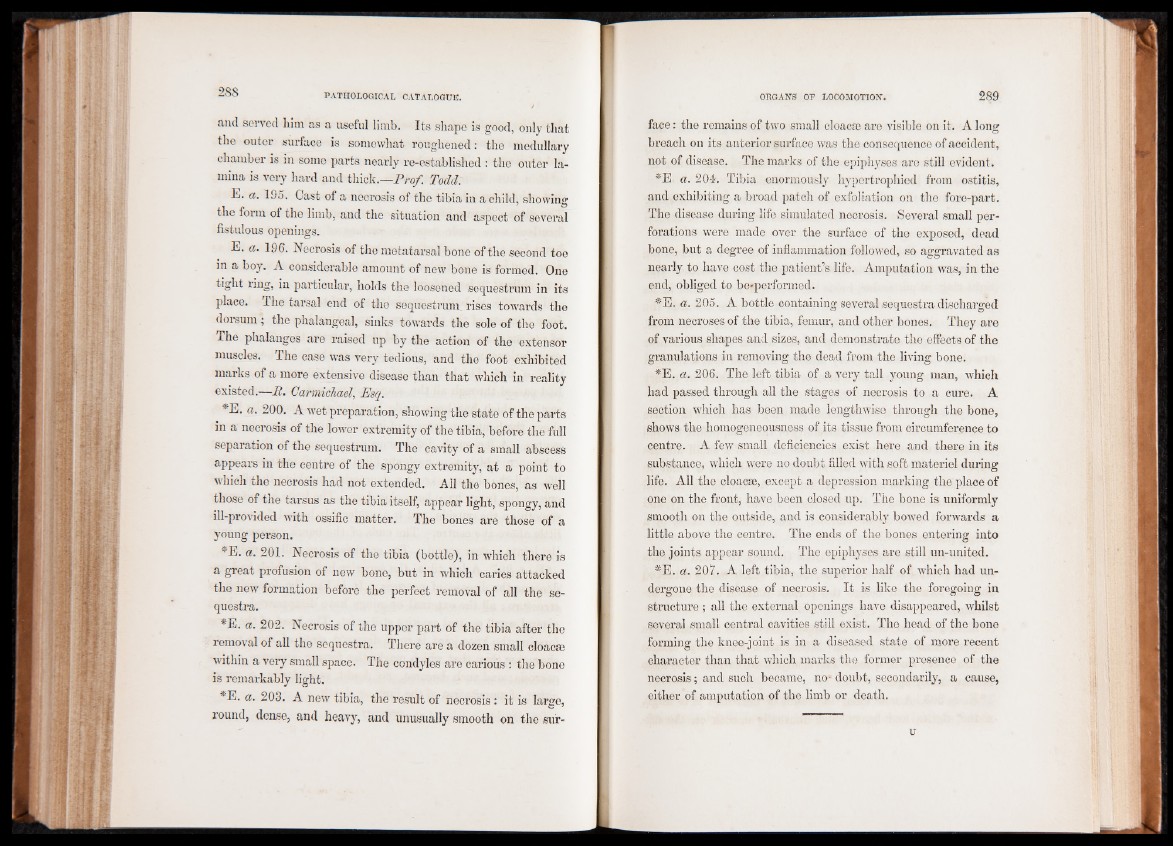
and served him as a useful limb. Its shape is good, only that
the outer surface is somewhat roughened: the medullary
chamber is in some parts nearly re-established : the outer lamina
is very hard and thick.—Prof. Todd:
E. a. 195. Oast of a necrosis of the tibia in a child, showing
the form of the limb, and the situation and aspect of several
fistulous openings.
E. a. 196. Necrosis of the metatarsal bone of the second toe
in a boy. A considerable amount of new bone is formed. One
tight ring, in particular, holds the loosened sequestrum in its
place. The tarsal end of the sequestrum, rises towards the
dorsum; the phalangeal, sinks towards the sole of the foot.
The phalanges are raised up by the action of the extensor
muscles. The case was very tedious, and the foot exhibited
marks of a more extensive disease than that which in reality
existed.—B. Carmichael, Esq.
*E. a. 200. A wet preparation, showing the state of the parts
in a necrosis of the lower extremity of the tibia, before the full
separation of the sequestrum. The cavity of a small abscess
appears in the centre of the spongy extremity, at a point to
which the necrosis had not extended. All the bones, as well
those of the tarsus as the tibia itself, appear light, spongy, and
ill-provided with ossific matter. The bones are those of a
young person.
*E. a. 201. Necrosis of the tibia (bottle), in which there is
a great profusion of new bone, but in which caries attacked
the new formation before the perfect removal of all the sequestra.
*E. a. 202. Necrosis of the upper part of the tibia after the
removal of all the sequestra. There are a dozen small cloacae
within a very small space. The condyles are carious : the bone
is remarkably light.
*E. a. 203. A new tibia, the result of necrosis : it is large,
round, dense, and heavy, and unusually smooth on the siirface:
the remains of two small cloacae are visible on it. A long
breach on its anterior surface was the consequence of accident,
not of disease. The marks of the epiphyses are still evident.
*E. a. 204;. Tibia enormously hypertrophied from ostitis,
and exhibiting a broad patch of exfoliation on the fore-part.
The disease during life simulated necrosis. Several small perforations
were made over the surface of the exposed, dead
bone, but a degree of inflammation followed, so aggravated as
nearly to have cost the patient’s life. Amputation was, in the
end, obliged to be«performed.
*E. a. 205. A bottle containing several sequestra discharged
from necroses of the tibia, femur, and other bones. They are
of various shapes and sizes, and demonstrate the effects of the
granulations in removing the dead from the living bone.
*E. a. 206. The left tibia of a very tall young man, which
had passed through all the stages of necrosis to a cure. A
section which has been made lengthwise through the bone,
shows the homogeneousness of its tissue from circumference to
centre. A few small deficiencies exist here and there in its
substance, which were no doubt filled with soft materiel during
life. All the cloacse, except a depression marking the place of
one on the front, have been closed up. The bone is uniformly
smooth on the outside, and is considerably bowed forwards a
little above the centre. The ends of the bones entering into
the joints appear sound. The epiphyses are still un-united.
#E. a. 207. A left tibia, the superior half of which had undergone
the disease of necrosis. It is like the foregoing in
structure ; all the external openings have disappeared, whilst
several small central cavities still exist. The head of the bone
forming the knee-joint is in a diseased state of more recent
character than that which marks the former presence of the
necrosis; and such became, no- doubt, secondarily, a cause,
either of amputation of the limb or death.
u